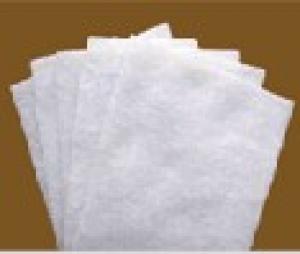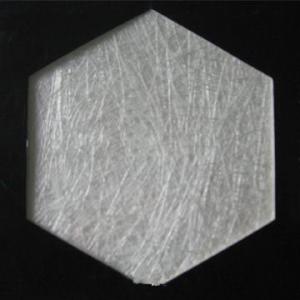150 G/M2 Nonwoven Geotextile Fabric for Road Construction - 1000g
- Loading Port:
- China main port
- Payment Terms:
- TT OR LC
- Min Order Qty:
- 1000 m²
- Supply Capability:
- 1000000 m²/month
OKorder Service Pledge
OKorder Financial Service
You Might Also Like

Features and Benefits
Nonwoven structure, providing excellent surface friction and built-in elongation
Effective filter, with tight pore size (AOS=70) and high permittivity
High tensile strength, with excellent puncture and tear resistance
Range from 3.2 oz/sy (109g/sm) – 16.0 oz/sy (543g/sm)
Geotextile uses:
Separate: Geotextile when used as a separation layer prevents two different fill materials such as aggregate and soil from combining. When used correctly the geotextile will increase the life span of the civil project, allowing the two separate layers to perform as designed for longer.
Protection: Geotextile when used as a protection layer acts as a cushioning barrier between the geosynthetic lining system and other layers of the dam or landfill cell. Generally the larger mass rolls of geotextile provide the best cushioning protection. As a protection barrier it helps prevent puncturing and leaks from external forces coming into contact with the liner.
Our Service
1.On a regular basis or as per your request,we entrust national testing agencies to conduct quality inspections
2. Strictly in accordance with the ISO9001-2008 international quality system standard,we monitor and manage the whole process throughout production,quality testing,and measurement to ensure product quality
3. For quality-related construction delay or substandard construction(except for damage or losses due to customer’s responsibility or irresistible natural disasters),we have refunding,replacement,and repair services.We will respond to customers’ feedbacks on quality issues within 24 hours.
FAQ:
Q: What kind of payments does jenor support?
A: T/T, L/C, Cash are accepted.
Q: Do you charge for the samples?
A: Accordeing to our company policy, the samples are free, we only charge the freight fee. And we will return the freight fee during the next order.
Q: Can you produce according to customers' design?
A: Sure, we are professional manufacturer, OEM and ODM are both welcome.
Q: Do you have other products?
A: Yes, please check the pictures:
- Q: Can geotextile skin be connected?
- Geotextile skin can be touched. Geotextile production of raw materials is polyester fiber, polyester has been widely used in daily life. Such as clothes are also a lot of polyester material. So do not worry, geotextile is not harmful to the human body.
- Q: What is the difference between nonwovens and geotextiles? What is the difference between geotextiles and nonwovens?
- Geotextile is divided into two non-woven geotextile and woven geotextile, non-woven geotextile and acupuncture and spunlace, staple fiber and long fiber. Nonwovens means that the manufacturing process does not require weaving. Geotextiles are used for geotechnical engineering. Geotextile is part of the textile does not require the manufacture can be made, called non-woven geotextile. Non-woven fabrics can be used very broad, like we use the heart of the soft wipes, are non-woven, as well as the hotel put the shoes of the shoes, but also non-woven.
- Q: How do geotextiles improve the performance of railway tracks?
- Geotextiles improve the performance of railway tracks by providing a stable and well-drained base for the tracks. They prevent the contamination of subgrade soil, control soil erosion, and enhance load distribution. Additionally, geotextiles reduce the formation of track deformations and increase the overall durability and lifespan of the railway tracks.
- Q: How do geotextiles help with soil stabilization in steep slopes?
- Geotextiles help with soil stabilization in steep slopes by acting as a barrier that prevents erosion and soil movement. They provide reinforcement to the soil, increasing its strength and stability, while still allowing water to drain through. This prevents the loss of soil particles, helps retain moisture, and promotes healthy plant growth, ultimately reducing the risk of landslides and erosion in steep slope areas.
- Q: How do geotextiles contribute to groundwater recharge projects?
- Geotextiles contribute to groundwater recharge projects by acting as a filtration and drainage system. They allow water to pass through while retaining sediment, preventing clogging of the recharge basins or infiltration trenches. This helps to enhance the recharge process, allowing more water to percolate into the ground and replenish the groundwater.
- Q: What is the geotextile material?
- Geotextile is made of staple fiber polyester, polypropylene, polyester filament, PP flat silk and other synthetic fibers through acupuncture or weaving made of geotextile, non-woven and industrial non-woven products in one. The general width of 1-6 meters, roll length of 50-100 meters, the quality per unit area of 100-600 grams square meters. According to the different production processes are: polyester / polypropylene staple acupuncture geotextile, PP flat wire woven geotextile, polyester spunbond filament geotextile, single double-sided thermal composite impermeable geotextile, woven geotextile and so on.
- Q: Can geotextiles be used in underground construction projects?
- Yes, geotextiles can be used in underground construction projects. Geotextiles provide various benefits such as soil stabilization, erosion control, filtration, and drainage, making them suitable for use in underground applications like tunnels, retaining walls, and underground drainage systems. They help improve the overall performance and longevity of the underground structures.
- Q: How do geotextiles improve the performance of geogrids?
- Geotextiles improve the performance of geogrids by providing additional reinforcement and stability. They act as a separation layer, preventing soil particles from migrating through the geogrids and reducing the potential for clogging. Geotextiles also enhance the drainage capacity of geogrids by allowing water to flow freely through the system, preventing the accumulation of water and reducing the risk of soil erosion. Moreover, geotextiles can increase the overall strength and load-bearing capacity of geogrids, making them more efficient in stabilizing soil and improving the overall performance of geogrid applications.
- Q: What are the different weight options available for geotextiles?
- Geotextiles come in various weight options ranging from lightweight to heavyweight. The weight options typically available include 3-5 oz/sq.yd for lightweight, 6-8 oz/sq.yd for medium weight, and 10-16 oz/sq.yd for heavyweight geotextiles.
Send your message to us
150 G/M2 Nonwoven Geotextile Fabric for Road Construction - 1000g
- Loading Port:
- China main port
- Payment Terms:
- TT OR LC
- Min Order Qty:
- 1000 m²
- Supply Capability:
- 1000000 m²/month
OKorder Service Pledge
OKorder Financial Service
Similar products
Hot products
Hot Searches
Related keywords
































